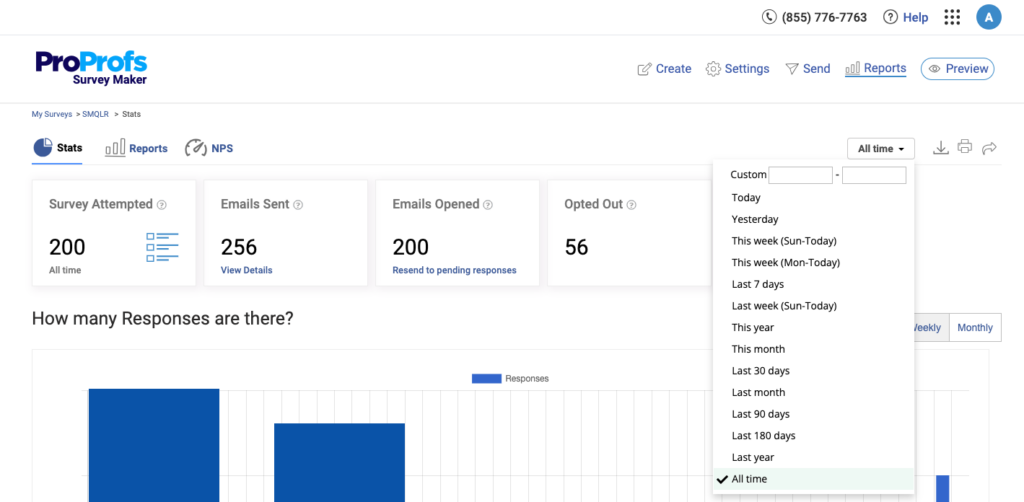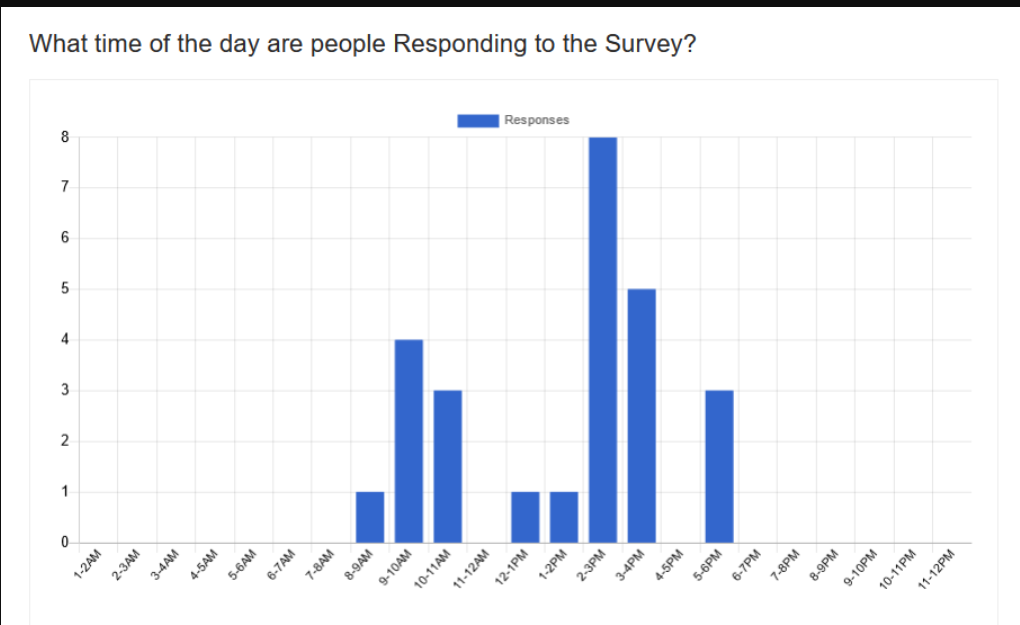
Yearly surveys can be valuable, but sometimes, you need a quicker way to gauge employee sentiments. Enter pulse surveys – short and frequent surveys designed to keep your finger on the pulse (no pun intended!) of your employees’ experience.
These bite-sized surveys provide timely and relevant feedback, allowing you to identify issues, track trends, and improve before things snowball. And the best part? They show your team that you value their opinions – a win-win for everyone!
In this blog post, we’ll unpack everything you need to know about pulse surveys and how they can benefit your business.
Let’s get started with a quick tutorial:
6 Quick Tips to Create Awesome Employee Engagement Surveys
What Is a Pulse Survey?
A pulse survey is a short, frequent survey designed to quickly gather feedback from employees or customers on various aspects of their experience. Unlike traditional surveys, which may be long and conducted annually or bi-annually, pulse surveys are typically brief and conducted regularly—weekly, monthly, or quarterly. This regular exercise allows organizations to continuously monitor mood, satisfaction, and engagement levels, providing real-time insights that can be acted upon swiftly.
Key Features of a Pulse Survey:
- Brevity: Usually, it is just a few questions long, making it quick and easy for respondents to complete.
- Frequency: Conducted on a regular schedule to track changes over time.
- Focus: Target specific areas such as employee engagement, customer satisfaction, or organizational culture.
- Actionable Insights: Provide timely data that can be used to address issues, capitalize on opportunities, and improve overall experience.
Here’s an example of what an employee engagement pulse survey looks like:

What Are the Best Employee Pulse Survey Questions?
To effectively gauge various aspects of employee engagement, satisfaction, and overall experience, it’s important to ask the right questions.
Here are several key categories with explanations and example questions, each utilizing a variety of question types.
1. Job Satisfaction
Understanding how satisfied employees are with their jobs helps identify areas for improvement and keeps morale high.
Questions:
1. Overall Satisfaction: How satisfied are you working for this company?
-
- Very disappointed
- Dissatisfied
- Neutral
- Satisfied
- Delighted

2. Work Enjoyment: How much do you enjoy your day-to-day tasks?
-
- A lot
- Somewhat
- Neutral
- Not much
- Not at all
3. Fulfillment: How fulfilling do you find your work?
-
- Extremely fulfilling
- Very fulfilling
- Moderately fulfilling
- Slightly fulfilling
- Not fulfilling at all
4. Pride: How proud are you to work for this company?
-
- Extremely proud
- Very proud
- Moderately proud
- Slightly proud
- Not proud at all
5. Work Motivation: How motivated do you feel to come to work each day?
-
- Very motivated
- Motivated
- Neutral
- Demotivated
- Very demotivated
6. Role Clarity: Do you have a clear understanding of your job responsibilities?
-
- Always
- Often
- Sometimes
- Rarely
- Never
7. Workload: How manageable is your workload?
-
- Very manageable
- Manageable
- Neutral
- Unmanageable
- Very unmanageable
2. Managerial Support
Assessing the quality of support from managers helps in understanding the effectiveness of leadership.
Questions:
1. Communication: How effectively does your manager communicate expectations?
-
- Very effectively
- Effectively
- Neutral
- Ineffectively
- Very ineffectively
2. Feedback: How frequently does your manager provide constructive feedback?
-
- Very frequently
- Frequently
- Occasionally
- Rarely
- Never
3. Support: How supported do you feel by your manager?
-
- Extremely supported
- Very supported
- Moderately supported
- Slightly supported
- Not supported at all
4. Approachability: How comfortable do you feel approaching your manager with concerns?
-
- Very comfortable
- Comfortable
- Neutral
- Uncomfortable
- Very uncomfortable
5. Goal Communication: How much would you agree with the following statement: “My immediate supervisor provides adequate direction when assigning tasks.”
-
- Strongly agree
- Somewhat agree
- Neither agree nor disagree
- Somewhat disagree
- Strongly disagree

6. Development: How much does your manager support your professional development?
-
- A lot
- Somewhat
- Neutral
- Very little
- Not at all
7. Recognition: How often does your manager recognize your achievements?
-
- Very often
- Often
- Sometimes
- Rarely
- Never
8. Trust: How much do you trust your manager’s decisions?
-
- Completely
- A lot
- Neutral
- Very little
- Not at all
3. Work Environment
The work environment greatly impacts employee well-being and productivity.
Questions:
1. Workspace: How satisfied are you with your physical workspace?
-
- Very satisfied
- Satisfied
- Neutral
- Dissatisfied
- Very dissatisfied
2. Flexible Working Hours: Does your manager allow flexible working hours to accommodate your personal needs?
-
- Yes
- No

3. Resources: Do you have the resources you need to do your job well?
-
- Always
- Often
- Sometimes
- Rarely
- Never
4. Safety: How safe do you feel in your workplace?
-
- Very safe
- Safe
- Neutral
- Unsafe
- Very unsafe
5. Colleague Relations: How well do you get along with your colleagues?
-
- Very well
- Well
- Neutral
- Poorly
- Very poorly
6. Company Culture: How would you rate the company culture?
-
- Excellent
- Good
- Neutral
- Poor
- Very poor
7. Work-Life Balance: How balanced do you feel your work and personal life are?
-
- Very balanced
- Balanced
- Neutral
- Unbalanced
- Very unbalanced
8. Work Stress: How often do you feel stressed at work?
-
- Never
- Rarely
- Sometimes
- Often
- Always
4. Engagement and Motivation
Evaluating engagement and motivation levels helps understand what drives employees and how to keep them committed.
Questions:
1. Engagement: How engaged do you feel with your work?
-
- Very engaged
- Engaged
- Neutral
- Disengaged
- Very disengaged
2. Company Mission: Do your professional goals align with the goals of the company?
-
- Yes
- No
- Somewhat
3. Opportunities: How often do you feel you have opportunities to learn and grow?
-
- Always
- Often
- Sometimes
- Rarely
- Never
4. Team Collaboration: How well do you think your team collaborates?
-
- Very well
- Well
- Neutral
- Poorly
- Very poorly
5. Recognition: How valued do you feel when your efforts are recognized?
-
- Very valued
- Valued
- Neutral
- Slightly valued
- Not valued
6. Purpose: How purposeful do you find your work?
-
- Extremely purposeful
- Very purposeful
- Moderately purposeful
- Slightly purposeful
- Not purposeful at all
7. Job Fit: How well do your skills and abilities match your job role?
-
- Perfectly
- Well
- Neutral
- Poorly
- Very poorly
5. Professional Development
Understanding how employees view their growth opportunities can help improve retention and satisfaction.
Questions:
1. Growth Opportunities: Do you feel you have sufficient opportunities for professional growth?
-
- Yes
- No
2. Feedback for Improvement: How well does your manager provide feedback that helps you improve your skills?
-
- Very well
- Well
- Adequately
- Poorly
- Very poorly

3. Training Programs: How effective are the training programs provided by the company?
-
- Very effective
- Effective
- Neutral
- Ineffective
- Very ineffective
4. Career Path: Do you have a clear career path at this company?
-
- Yes
- No
5. Mentorship: How beneficial is the mentorship you receive from your manager or senior colleagues?
-
- Very beneficial
- Beneficial
- Neutral
- Not beneficial
- Not beneficial at all
6. Skills Development: How often do you get opportunities to develop new skills?
-
- Always
- Often
- Sometimes
- Rarely
- Never
7. Feedback for Growth: How useful is the feedback you receive in helping you grow professionally?
-
- Very useful
- Useful
- Neutral
- Not useful
- Not useful at all
8. Support for Goals: How supportive is your manager in helping you achieve your career goals?
-
- Very supportive
- Supportive
- Neutral
- Unsupportive
- Very unsupportive
How to Read & Analyze Pulse Surveys
Gathering data is just 50% of the work. The other 50% involves analyzing the data and making sense of it.
First things first, you’ll need a survey maker tool that will help you create employee pulse surveys and gather all the data for you to read and analyze. It will be pretty much straight forward from this point.
We’ll take ProProfs Survey Maker as our tool of choice as it is one of the most versatile and easiest pulse survey tools to work with.
This process has three distinct parts. They are as follows:
1. Accessing Results
First, you need to access the results of your pulse surveys if you want to analyze them. When you log into ProProfs Survey Maker, you will be taken to the dashboard, where you can see all the surveys you have created. Navigate to your pulse survey and click on the number (reports and statistics) under the “Reports” section.
![]()
2. Reading Results
Once you click on the reports and statistics section, you will be taken to the reports page, which will give you all the details of the survey takers.

From here, you can view each response, the date it was sent, the email, and the comments attracted to it. You can filter the data, change the number of columns you want to see, and even download the entire report.

3. Interpreting the Results
On the reports page, select “Stats” from the top of the menu, and you will be taken to the automatically generated statistical reports page.

Here, you can see the number of responses collected along with each response separately. You can get a quick visual overview of what time of day people respond the most, which day of the week they respond the most, and many other things.

The charts make it extremely easy to interpret the metadata of your surveys without any manual work.
You can also share your responses by clicking on the “Share” button at the top right. Once you click share, you get a secret URL that you can relay internally or externally to stakeholders.
How to Choose Questions for Pulse Surveys
Choosing the right questions for pulse surveys is crucial to ensure that you gather actionable insights without overwhelming your respondents. Here are some steps to help you select the most effective questions for your pulse surveys:
1. Identify Your Objectives
Before selecting questions, clearly define the goals of your survey. Are you aiming to gauge employee satisfaction, monitor engagement levels, identify potential issues, or gather feedback on recent changes? Knowing your objectives will help you choose questions that align with your survey’s purpose.
Example Objective: If your goal is to measure job satisfaction, focus on questions related to overall satisfaction, role clarity, and work-life balance.
2. Keep It Concise
Pulse surveys are designed to be brief and frequent. Limit your survey to 5-10 questions to ensure high response rates and to avoid survey fatigue.
Tip: Prioritize the most important questions that will provide the insights you need.
3. Use a Mix of Question Types
Variety in question types keeps the survey engaging and helps you gather different kinds of data. Use a combination of multiple-choice, Likert scale, open-ended, and rating scale questions.
Example:
- Multiple Choice: “How often do you receive feedback from your manager?”
- Likert Scale: “On a scale of 1-5, how satisfied are you with your current role?”
- Open-ended: “What can we do to improve your work experience?”
4. Ensure Clarity and Simplicity
Questions should be clear, concise, and easy to understand. Avoid jargon or complex language that might confuse respondents. Each question should address a single issue to ensure clarity.
Example: Instead of “How satisfied are you with your work environment and resources?”, ask “How satisfied are you with your work environment?” and “How satisfied are you with the resources provided?”
5. Focus on Actionable Insights
Choose questions that will provide data you can act on. Each question should aim to uncover information that can lead to meaningful changes or improvements.
Example: “Do you feel that your contributions are recognized?” This question can help determine whether recognition programs need improvement.
6. Align With Survey Frequency
Since pulse surveys are frequent, the questions can be rotated or adjusted over time to cover different aspects of the employee experience without redundancy.
Tip: Rotate between topics such as job satisfaction, management support, and career development in different surveys.
7. Test and Refine Questions
Pilot your questions with a small group before full deployment to ensure they are understood as intended. Gather feedback and refine your questions based on the pilot results.
Example: If respondents found a question unclear, rephrase it for better clarity.
Consider Anonymity
Ensure that the questions are designed in a way that respondents feel safe and comfortable providing honest feedback. Guaranteeing anonymity can help increase the candor of responses.
Example: “How comfortable do you feel providing feedback to your manager?” Respondents are more likely to answer honestly if they know their responses are anonymous.
FREE. All Features. FOREVER!
Try our Forever FREE account with all premium features!
What Are the Benefits of Employee Pulse Surveys?
Traditional annual employee surveys offer valuable insights, but what happens in the long gap between them? Employee sentiment can shift quickly, and waiting a year to address issues can leave your workforce feeling unheard and disengaged. This is where employee pulse surveys matter. These short, frequent surveys offer a treasure trove of benefits like:
- Real-Time Insights: Unlike annual surveys, pulse surveys capture feedback in the moment, allowing you to identify issues and trends as they arise. This real-time data empowers you to address concerns early on before they escalate.
- Improved Employee Engagement: Regularly asking for feedback shows employees their voices are valued. This fosters a culture of open communication and increases their sense of investment in the company’s success.
- Boosted Morale: Addressing concerns raised in pulse surveys demonstrates that you’re actively working to create a positive work environment. This proactive approach can significantly improve employee morale and overall satisfaction.
- Increased Productivity: Pulse surveys can help your team work smarter and more efficiently by identifying and resolving issues that may be hindering productivity.
- Reduced Turnover: Employees who feel heard and valued are more likely to stay with the company. Pulse surveys provide a platform for employees to express concerns, helping you proactively address issues that might otherwise lead to them leaving.
- Data-Driven Decision-Making: Pulse surveys provide valuable data on employee sentiment, allowing you to make informed decisions about policies, processes, and initiatives that impact your workforce.
- Improved Communication: Regular pulse surveys encourage open communication from employees. By understanding their perspectives, you can tailor communication strategies to ensure everyone feels informed and engaged.
How Can You Get the Most out of Pulse Surveys for Your Company?
Employee pulse surveys are a valuable tool, but they need to be done correctly for the best results. Here’s how to maximize the impact of your pulse surveys and turn them into a recipe for a thriving work environment:
- Ask the Right Questions: Tailor your pulse surveys to address current concerns or initiatives. Avoid generic questions and focus on specific areas where timely feedback can make a difference.
- Keep it Short & Sweet: People are busy! Shorter surveys (think 5-10 questions) with a clear focus are more likely to get a high response rate.
- Maintain a Regular Frequency: While bombarding your team isn’t ideal, regular pulse surveys (monthly or bi-weekly) capture trends and ensure issues are addressed promptly.
- Keep it Anonymous: Anonymity encourages honest feedback. To build trust, utilize anonymous survey tools and emphasize confidentiality.
- Communicate, Communicate, Communicate: Don’t let feedback gather dust! Communicate survey results clearly and transparently. Let your team know what actions are being taken to address their concerns.
- Close the Feedback Loop: Show employees you value their input by taking action based on feedback. Communicate the changes being made and how they address the issues raised.
- Celebrate Successes: Don’t just focus on the negative! Recognize and celebrate positive feedback and improvements implemented based on survey results. This reinforces the value of participation.
Watch: How to Assess Employee Satisfaction With Surveys | Training Course Introduction
What Can Pulse Surveys Measure?
Employee pulse surveys offer a valuable snapshot of your workforce’s well-being, but what exactly can they measure? Here’s a breakdown of some key areas pulse surveys can illuminate:
- Employee Engagement: Pulse surveys can assess how engaged employees feel with their work, their team, and the company overall. Questions might gauge enthusiasm for projects, satisfaction with workload, and alignment with company goals.
- Managerial Effectiveness: These surveys can provide insights into how employees perceive their managers’ leadership style. Questions might address communication clarity, feedback effectiveness, and support for professional development.
- Work-Life Balance: Pulse surveys can assess the balance between work demands and personal life. Questions could address workload distribution, overtime frequency, and access to flexible work arrangements.
- Company Culture: These surveys can help you understand the overall work environment. Questions might address collaboration levels, recognition practices, and opportunities for growth within the company.
- Specific Initiatives: Pulse surveys can be tailored to measure employee sentiment towards specific company initiatives or changes. This allows for real-time feedback and adjustments before issues become entrenched.
- Employee Wellbeing: Pulse surveys can indirectly measure employee well-being by gauging their stress levels, sense of belonging, and overall satisfaction with the work environment.
- Customer Satisfaction (for B2C companies): These surveys can also be adapted for customer interactions. Pulse surveys can measure customer satisfaction with specific products, services, or recent interactions with your company.
How Often Should You Run Pulse Surveys for Your Employees?
Employee pulse surveys are a game-changer for gauging employee sentiment, but how often should you use this powerful tool? There’s no one-size-fits-all answer, but here are some thoughts on how to find the sweet spot for your organization:
Finding Balance:
The key lies in striking a balance between gathering valuable feedback and avoiding survey fatigue. Sending surveys too frequently can overwhelm employees and decrease response rates. However, waiting too long between surveys might miss critical trends or emerging concerns.
Frequency Considerations:
Here are some factors to weigh when determining your ideal pulse survey frequency:
- Company Size: Smaller teams might benefit from more frequent surveys (bi-weekly) due to faster changes in dynamics. Larger organizations might opt for monthly surveys.
- Industry: Fast-paced industries with frequent changes might require more frequent pulse checks (every 2-3 weeks) to stay on top of employee sentiment.
- Current Initiatives: If you’re implementing new programs or undergoing significant changes, consider more frequent pulse surveys (every 2-4 weeks) to track their impact.
- Survey Length and Complexity: Shorter, more focused surveys can be conducted more frequently (weekly or bi-weekly) compared to longer, more in-depth surveys (monthly or bi-monthly).
General Guidelines:
Here are some general recommendations for pulse survey frequency:
- Weekly: Ideal for highly dynamic environments or to closely monitor specific initiatives.
- Bi-weekly: Good balance for capturing trends without overwhelming employees.
- Monthly: Effective for most organizations and allows for analysis of trends over time.
- Bi-monthly or Quarterly: This can be sufficient for larger organizations with stable environments but may miss crucial insights.
Remember, consistency is key! Choose a frequency you can maintain and stick to it. It’s better to have regular, shorter surveys than sporadic, long ones.
Additional Tips:
- Track response rates: If response rates dip, consider adjusting frequency or survey length.
- Mix things up: Vary question types and topics to keep surveys engaging.
- Communicate clearly: Explain the purpose of surveys and how feedback is used.
By carefully considering these factors and choosing the right frequency, you can leverage employee pulse surveys to their full potential, fostering a work environment where employees feel heard and valued.
FREE. All Features. FOREVER!
Try our Forever FREE account with all premium features!
Gauge Employee Satisfaction With Ease Through Pulse Surveys
Forget annual surveys that gather dust – employee pulse surveys are the real-time feedback engine your business needs! These quick, convenient surveys deliver instant insights into employee engagement, satisfaction, and areas ripe for improvement.
Implementing pulse surveys can streamline feedback, allowing for quick and efficient analysis. This continuous loop of feedback and improvement benefits the employees and contributes to the organization’s overall success.
Regularly engaging with employees through pulse surveys fosters a culture of openness and continuous improvement, ultimately leading to a more motivated and committed workforce.
If you are looking for inspiration or don’t know where to start, you can begin by choosing the perfect tool! Here’s a quick guide:
How to Choose the Best Survey Software
To know more, sign up for free or get a demo.
Frequently Asked Questions
1. What type of survey questions should you ask employees?
Ask questions about job satisfaction, managerial support, work environment, engagement, and professional development. For comprehensive insights, use a mix of multiple-choice, Likert scale, and open-ended questions.
2. How long should my pulse survey be?
A pulse survey should be brief, typically 5-10 questions, to ensure high response rates and avoid survey fatigue.
3. What makes pulse surveys more effective?
Pulse surveys are effective when they are short, frequent, and provide real-time insights. They should give quick feedback, encourage timely action, and support continuous improvement.
 Tips
Tips
We’d love to hear your tips & suggestions on this article!
FREE. All Features. FOREVER!
Try our Forever FREE account with all premium features!


 We'd love your feedback!
We'd love your feedback! Thanks for your feedback!
Thanks for your feedback!







